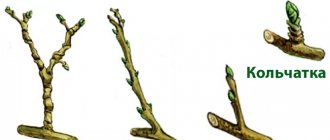QUESTION: climbing rose bush growing in my garden . But the place for the plant was not very well chosen and now I would like to replant . What should you pay attention to when choosing a new site, how and when to replant?
Transplanting a climbing rose
ANSWER: to replant roses (especially those with long, powerful shoots - climbing, scrub or park ) in early autumn, from September to early October. In this case, the seedlings have time to take root before winter. But you can transplant climbing roses in the spring, as soon as the soil thaws and the buds on the roses have not yet begun to grow.
Unfortunately, you didn’t write what kind of rose you have. Let's try to determine it together. A true climbing rose - rambler - has thin, flexible shoots that can reach 3-4 m in length with small double or simple flowers with a diameter of 3-4 cm. It blooms for 35-45 days, but once.
If you have a rambler, remove the shoots from the support (if they were attached to it) before transplanting. Save all the young shoots that appeared this year; at the end of August, pinch off their tops so that they have time to become woody, since these roses bloom mainly on last year's shoots. And remove all shoots older than two years immediately after flowering.
Optimal deadlines for completing work
Professionals believe that planting and replanting large trees and shrubs is best done in winter. For this, special equipment is used. If it is not possible to use a manipulator, then the old method of gradually transferring adult woody plants to another place is used. The older the rose, the more important it is to carry out the work consistently. Prepare the plant in the fall and plant in the spring.
The work is performed in this order:
- In autumn, after the leaves fall, the climbing rose is pruned. All shoots, without exception, are shortened to a height of 20-25 cm. (It looks as if the hybrid tea variety is being prepared for wintering).
- The bush is watered abundantly; you will need 30 - 40 liters of water. After this, the plant is left for 2 - 3 days so that the water moistens the roots to their full depth.
- The outline of the future coma is outlined around the rose. Its diameter is 30–50 cm, depending on the size of the bush. The older the rose, the larger the com.
Tip #1 . You should not form a lump that is too large if it is carried manually, without mechanical lifts.
- A trench is dug along the intended contour, 30–50 cm deep and 30 cm wide. To transplant roses in the spring, a lump is formed in the fall.
The roots that protrude beyond the coma are carefully trimmed with sharp pruning shears, and roots that are too thick are shortened using a garden hacksaw.
- A ring-shaped trench is formed around the bush. It is filled with sand. Before the onset of frost, the bush produces new roots, which manage to grow stronger before the onset of cold weather. The root system is concentrated in the fertile layer, strengthening the lump, as if entangling it with a web.
- The ground part is hilled up. The shoots and ground around the bush are covered with leaves or covered with spruce branches to protect the bush from frost. In severe winters, the shelter needs to be strengthened. Various types of spunbond are used. If this is not the case, you can use a natural remedy, shovel more snow.
In this form, the rose overwinters until spring transplantation. During this time, the regrown roots will strengthen and the lump will thicken. This state of the plant will significantly reduce stress on the plant when it is moved to a new location (
Trimming climbers
Despite the fact that climbers bloom on both last year’s and young shoots, it is still advisable to regularly remove old branches. Flowering on them worsens, they are more susceptible to all sorts of diseases, and they simply make the bush unkempt and unkempt.
It is not necessary to prune climbers in the fall, especially if your region has harsh winters. If you are sure that the plant will overwinter without problems, you can remove too old, damaged shoots.
In spring, the main pruning of climbers is carried out. Three-year-old shoots (on which the rose most likely will either not bloom at all or will bloom sparingly) are cut into a ring. Damaged, frozen, dry shoots are removed. Dried tops of two-year-old shoots are slightly trimmed. Small side shoots are pruned to 1-2 buds.
Climber trimming diagram
It is quite difficult to distinguish a two-year-old shoot from a three-year-old shoot of climbing roses. Therefore, if you have doubts, it is advisable to mark them with multi-colored ribbons or tags.
Selection and preparation of a new seat
After the rose has been prepared, they begin to create optimal conditions for it in a new place. Replanting is a troublesome and difficult undertaking, so it is important to correctly determine the location in the garden in advance and provide the necessary conditions.
- In the garden, choose an open, well-lit area. Its area takes into account the maximum growth of the variety and the need for shelter for the winter.
- They provide protection from the wind, but at the same time exclude shading from tall plants and structures.
- Preparing the planting hole.
The size of the pit should be twice the size of the coma, but not less than 0.5 m in diameter and depth.
If the land in a new place is poor, it needs to be replaced with imported fertile soil. For roses you will need light or medium loam, neutral reaction and a humus content of 4% or higher. If it is not possible to deliver purchased soil, you need to optimize what is on the site.
Improving additives for sandy natural soil:
| Sod (or garden) soil | 2 parts |
| Humus of animal origin (preferably mullein) | 1 part |
| Leaf soil (or compost) | 1 part |
| Phosphrite flour (or precipitate) | 40 – 60 g |
| Potassium salt | 20 – 30 g |
Tip #2 . Note! Phosphorite flour and tsepitat are used as phosphorus fertilizers, only for long-term soil preparation for planting and are not used in the current feeding of roses.
Phosphorus-potassium fertilizers can be replaced with wood ash by adding 300 - 500 g to the soil for one planting hole 50 cm x 50 cm x 50 cm (
How to plant in spring
When planted in spring, plants lag behind in development and require serious care. In areas with a temperate climate, plants should be planted in the fall. The procedure is carried out at the end of September or beginning of October.
Container
When purchasing such roses, it is worth studying the shoots in detail. They should be strong and not very elongated. Such a rose will hurt and will not survive frosts. To plant a plant, you should dig a hole that is 10 centimeters larger than the size of the container. A layer of soil should be placed at the bottom, the plant should be pulled out and placed in class=”aligncenter” width=”1200″ height=”794″|fcw3qayjh5a| src=”https://vosadu-li-vogorode.ru/wp-content/uploads/1/a/0/1a0bcd8efe12809c4aac526cf61ca787.jpeg” class=”aligncenter” width=”1200″ height=”800″|fcw3qayjh5a| src=”https://vosadu-li-vogorode.ru/wp-content/uploads/7/4/c/74c3f93650ed3c9fec6704d462a78319.jpeg” class=”aligncenter” width=”1140″ height=”628″|fcw3qayjh5a| src=”https://vosadu-li-vogorode.ru/wp-content/uploads/9/7/a/97ac3c52f68e6b0193cbad8b3faf249b.jpeg” class=”aligncenter” width=”1280″ height=”770″|fcw3qayjh5a| src=”https://vosadu-li-vogorode.ru/wp-content/uploads/9/a/8/9a80dd1f2228d02a114347fa57128c44.jpeg” class=”aligncenter” width=”750″ height=”500″|fcw3qayjh5a| src=”https://vosadu-li-vogorode.ru/wp-content/uploads/3/8/9/3897bb3f617eba5e1be3c9441db784d2.jpeg” class=”aligncenter” width=”900″ height=”615″|fcw3qayjh5a| src=”https://vosadu-li-vogorode.ru/wp-content/uploads/a/f/2/af29a32d5c22721bc894b6d22c1fae27.jpeg” class=”aligncenter” width=”1024″ height=”683″|fcw3qayjh5a| src=”https://vosadu-li-vogorode.ru/wp-content/uploads/8/9/e/89e4a9ae7ee6c4249918521463ea8796.jpeg” class=”aligncenter” width=”1280″ height=”720″[/img]
Fill the empty space with soil and compact it carefully. Water generously and top up the soil after moisture has been absorbed.
Step-by-step instructions for replanting a climbing rose
When the autumn work is done correctly, replanting in the spring is much easier.
| Step 1 | After the snow melts, free the rose bush from its shelter. Remove all protective material and clear the ground around the bush of plant debris. |
| Step 2 | Dig around the bush, removing the sand to expose the formed lump. |
| Step 3 | Using burlap or other durable but elastic material, wrap the sides of the ball in several layers and tie tightly with strong rope. |
| Step 4 | After this, use a shovel to carefully separate the bottom of the lump from the ground. |
| Step 5 | Carefully lifting the lump, place a strong cloth under it. When it is completely placed under the bush, two or four people use its ends to lift the rose out of the hole and carry it to a new planting site. |
| 3. If the lump is not wrapped, the soil may wake up and the rose will not take root. | |
| Step 6 | In the planting hole, form a depression 2 times larger than the rose clump. The depth is such that the root collar is 5–8 cm below the edge of the planting hole. |
| Step 7 | Place the rose in the hole and remove the side winding. The burlap, which was used for carrying, does not need to be removed. It will not interfere with survival. If the bush was not transported in plastic film or other non-decomposing material, then it must be carefully removed from the bottom of the coma, so as not to damage it. |
| Step 8 | The lump is sprinkled with fertile soil. |
| Step 9 | Form a tree trunk circle and water it. You will need 30 - 40 liters of water. |
If everything is done correctly, after 3 - 4 weeks young shoots will appear on the rose.
Support
The climbing rose definitely needs support. Their diversity is amazing. For these purposes, both a specially purchased structure and improvised items are suitable. For example, it could be an old tree on the site, a fence. You can order a support for climbing roses of various shapes and designs. This could be an arch or lattice, which will be made of metal, wood or plastic. The last option is the most preferable. Polymers are resistant to adverse environmental influences.
However, you should not choose a gray, faceless wall as a support. Even these beautiful plants will not be able to improve the appearance of an old utility shed for equipment. It is better to purchase a support for them separately.
It is worth noting that when the branches are fixed in a horizontal plane, flowers will appear along the entire length of the shoots. If you fix them in a vertical position, the buds will appear only in their upper part.
To secure the branches, you need to use twine made of polymer materials. Never use wire for these purposes, even if it is wrapped in cloth or paper. The supporting structure should be at least 50 cm away from the rose.
Category: “Questions and answers”
Question No. 1. Until what age can climbing roses be replanted?
Theoretically, this can be done without restrictions. Roses can grow in one place for up to fifty years. In the practice of park construction, there have been cases when plants that were several decades old were moved because they were of historical value.
The period of biological flowering of a rose falls on the first 20 - 25 years. If the plant is older, then replanting does not make sense. It is better to buy a young climbing rose of the same variety.
Question No. 2. When is it better to replant a rose in spring or autumn?
Most gardeners are inclined to replant in spring with preliminary preparation.
roses in the fall of the previous year.
Features of care after flowering
What to do when the roses have faded
With the beginning of the autumn period, you should begin preparing roses for the winter period. From the last days of August, you need to completely stop watering and loosening the soil and start feeding with potassium instead of nitrogen. The upper part of unripe stems must be removed. Such roses must be covered for the winter, but first they are removed from the supporting structure and placed on the surface of the soil. It is very easy to place a young plant on the ground. It is not easy to lay an adult specimen on the ground, and this can take up to 7 days. It must be remembered that at sub-zero temperatures the shoots become fragile and can break.
How to cover climbing roses for the winter
You need to cover the plant when the air temperature drops below minus 5 degrees. This should not be done earlier, because the flowers must harden, and they may also begin to rot or grow (which is associated with a long stay under cover without air). Shelter should be done in non-rainy, windless weather.
You need to remove the leaves from the removed shoots, cut off the damaged stems, tie the lashes using a rope, and then carefully place them on the litter. To create it, you can use dry leaves or spruce branches.
Do not place the plant on bare soil. Press or fix the plant on the surface of the soil, and cover it with dry leaves or grass, or you can also use spruce branches. The base of the bush should be sprinkled with soil or sand, and then cover the plant with lutrasil, polyethylene film, roofing felt or other material that cannot get wet. There should be a layer of air between the plant and the shelter.
Best time to plant
The timing of planting climbing roses in the spring depends on the local climate and weather, which is impossible to predict. However, experienced flower growers have still determined the approximate time suitable for this:
- In the south of the country, roses are planted in open ground with the onset of April. The deadline is early May.
- In central Russia and the Moscow region, the climate is harsher, so it is better to plant bushes from late April to late May.
- In the Urals and Siberia with a harsh continental climate, it is advisable to plant from late May to mid-June.
You cannot be guided only by these recommendations. Therefore, monitor the weather and soil conditions. It should have time to warm up to +8...+10 oC. Otherwise, the roses will not take root and take root well. For planting, you should choose a cloudy and quiet day, when there is no bright sun, precipitation or strong wind.
Why do you need to transplant roses from one place to another?
Transplanting roses in the fall of 2022 will be painless if you transplant flowers following the rules of agricultural technology, guided by the recommendations of astrologers and the lunar calendar. Usually, bushes are replanted in order to save the flower crop. The plant should not be moved unless absolutely necessary. There are several reasons for replanting:
- Various diseases and lack of color can provoke the complete death of a flower crop. In such a situation, replanting will be a lifesaver for rose bushes.
- If neighboring plantings have become an obstacle to the full development of a garden rose, then their planting is simply vital for the plant.
- Deaf shading of plantings by trees and buildings has a detrimental effect on the growth of roses. Rose bushes require a lot of sun. Its absence provokes diseases.
- Mature bushes may stop flowering beautifully. The inflorescences will be small and lose their aesthetics. After changing the location, the flowering will again become lush and beautiful.
- It is urgently required to replant when the presence of groundwater is detected near the roots of the plant. This often occurs during flooding or excessive rainfall. Otherwise the roses will rot.
- If the soil in the garden area is depleted or has changed its composition, then “moving” to a new, specially prepared place will be a lifesaver for the flower.
On a note!
These are the main reasons for replanting, which require immediate action.











